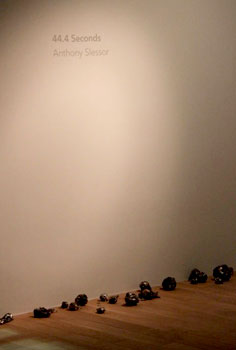Anthony Slessor
Reviews
44.4 SECONDS – TOTEMS OF SUFFERING
Leila Mehulić, Senior Curator Mimara National Museum, Curator RaGa, Zagreb 2012
The history of civilization, from the destruction of Carthage and Jerusalem to the destruction of Dresden, Hiroshima, and the people, soil and trees of Vietnam, is a tragic record of sadism and destructiveness.[1]
Fromm’s testimony of human permanent obsession with absolute power and our desire to transform the living into the dead as consequences of the absence of spiritual autonomy, constantly justified by the political and historical context, experiences a painful mise-en-scene in the work of Anthony Slessor, British artist also branded by the war.
After the works Eastern Frontier and Disorient, the installation dedicated to the tragedy of Hiroshima, preceded by 44.4 seconds of the fall of the atomic bomb cynically named ‘Little Boy’, is another work from the ‘Totems of Mourning’ series in which the artists provokes a man devoid of empathy towards historical tragedies.[2]
Shaping the mimesis of an apocalyptic landscape, ‘Ground Zero’, a 4.4 square mile area destroyed in the explosion, Slessor followed the path of memories and reconstructed the event like a documentarian, using the archival record of the indifferent military report about the event as soundtrack. Such an expressive narrativity is due to the fact that almost each of Slessor’s themes sprang from found circumstances – the material at hand and spatial conditions. This kind of approach seems to reflect the ‘old English inclination towards empirics, leading to direct, inductive conclusion from concrete materials and objects.’[3]
Slessor’s work is in many ways related to local heritage and encompasses several movements in British sculpture tradition, one of the most impressive phenomena in the late 20th century. The anxious atmosphere of a country that replaced the war against Nazism with the Cold War against Communism is evident from the work of a group of artists that made a name for themselves at the 1952 Venice Biennale. The mutual thread of their sculptures was an inclination towards totemism and archaic motives, which approached Slessor’s work through the handwriting of William Turnbull. Slessor’s design of ambience akin to a fictitious archaeological site (Grail, Edges), or a creation of imaginary fossil traces (Out of Water) might testify of a desire to create personal mythology.
Understandably, Slessor’s work largely resembles the principles of the father of British modern sculpture Anthony Caro, who abandoned traditional components of sculpture – mount, solid core and verticality. Just like Caro’s, Slessor’s expression also experiences full affirmation in the interior, which is part of sculpting matter, a volume filled with energy. The capability of creative transformation of the appropriated is most evident in the work Dream Tree Keys, which repeats Caro’s series of experiments with balance (Table Pieces). A part of the sculpture that stretches over the edge of the base acquires a biomorphic, sumptuous shape that challenges our decision to perceive it as a sculpture.
Combining profound penetrations into matter and a low linear relief, the sculpture entitled 44.4 Seconds, made of lead, is a fusion of graphics and sculpture. Slessor always develops his sculptures from the physical and symbolic shapes of its matter. Lead, which alchemists connected with Saturn, the Master of Melancholy, becomes in its suppleness a graphic medium in which the artists inscribes his ‘ideograms of suffering’ (André Malraux)[4]. The said organic approach and selection of unorthodox materials – melted lead, paper, wax, gravel, tree, rosin, cotton, charcoal, plaster and ink, can be compared with the sensibility of the Post-minimalism and process art, whose ephemeralness opposes aggressive materialism of the human civilisation. His thermic sculpture Animé consists of tree rosin captured in blocks of ice and thus presents a comforting counterpoint to the echo of Japanese tragedy. When the ice vanishes, it will finally release wondrous shiny bodies. Because ‘death destroys a living creature, and afterwards oblivion, completing death’s work, gradually erases what death had spared, but even when the very last memory of the deceased and the last trace of his short life on earth, and moreover his name vanish from the people’s memory, still this mysterious existence, forgotten, unknown, destroyed, crushed by the multiplicity of centuries will keep something indestructible and imperishable and nothing, absolutely nothing in the world can destroy that’[5]. — Leila Mehulić
[1] Erich Fromm, The Anatomy of Human Destructiveness, I, Naprijed, Zagreb, 1986., p. 180.
[2] Darko Glavan, Crni krajolici, catalogue to the exhibition Josip Roca, Mimara Museum, Zagreb, 14 Sept – 21 Sept 2007, p 1.
[3] Manfred Schneckenburger, Sculptures and Objects: Art of the 20th Century , VBZ, Zagreb, 2000, p. 572.
[4] Leonida Kovač, Izmislite sebe, catalogue to the exhibition of Gorki Žuvela, Croatian Academy of Science and Art – Glyptotheque, 17 Feb – 15 Mar 2009, p 13.
[5] Georg Wilhelm Friedrich Hegel: Fenomenologija duha, Naklada Ljevak, Zagreb, 2000.licopters in the military reserves and also in civil aviation.


